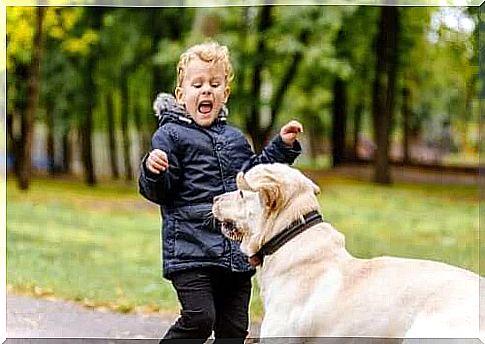My Child Is Afraid Of Animals: What Should I Do?

Not all children react the same way when they see a dog or other pet. Some want to cuddle with them and feel very attracted to them. Others prefer to stay away, indicating that they are afraid of animals.
There is no specific reason why this happens. Sometimes it may be due to a previous bad experience or that they have learned that an unknown animal can be dangerous. There are also children who simply feel intimidated by the strange shape of animals.
“There are more active and adventurous children, while others are calmer and less open to new experiences. The latter feel more stressed when faced with something new and unknown “, says Dr. Tracy Dennis from the Department of Psychology at Hunter College.
Although fear is a defense mechanism that keeps children safe, it is best to teach them to show respect and be careful instead of fearing animals, which keeps them from experiencing the enriching experience of exploring them.
How to help children who are afraid of animals
Here are some tips to help parents help their children take the step between fear and respect:
Try to understand the fear

Fear is irrational. It will therefore not help to force children not to be afraid of animals.
It is best to try to understand what is causing the fear and seek a strategy to help them deal with it. For example, if your child is afraid of a dog because of its size, suggest them not to approach a large one.
When you are with a smaller and easier dog, approach it first and then encourage your child to follow along while protecting it.
Teach them to approach animals
Children can approach the animal awkwardly or with too many emotions, and scare it, which usually causes a violent reaction that will scare the animal even more.
It is best to guide them in each step and carefully choose the words you use. It is best to avoid words that make them vigilant, such as “be careful not to bite you” or “do not go too close, it can be dangerous”. Use positive reinforcement such as “approach the animal with love” or “be kind to the animal”.
Start teaching your child that you should always ask permission from the animal owner before approaching the animal. It is therefore better to let your children let the animal smell to their hand before trying to pet it. Both dogs and cats feel more comfortable after smelling a new person.
Try to distract the animal by eating its face. Then invite your child to touch the animal from one side, preferably not by the tail, to avoid scaring the animal. The face of the animal can be scary for the child.
Avoid puppies if your child is afraid of animals

Young animals are more unpredictable than adults. For them, play can be biting, scratching or jumping over people. What to an animal may be a sign of trust, joy, and love may seem like a hostile act to a child.
Learning the language of animals
Pets have a unique way of communicating with people. It can be very helpful to learn that language and pass it on to your children to facilitate a meeting.
For example, Linda Case, author of the book, Canine and Feline Behavior and Training: A Complete Guide to Understanding Our Two Best Friends, says that “an open mouth with the lips back, the tongue out, and a relaxed face are an invitation to interact.”
Teach your child to interact with animals

Just like puppies, children are unpredictable. That fear can turn into excitement when the first encounter with the animal is successful. With that feeling, their actions can scare or annoy the animal. Explain to your child that they must not push the animal, grab their fur or pull them by the tail.
Do not take a pet home if your child is afraid of animals
Many parents think that it is a good idea to take a pet home. Maybe your child and pet will get used to each other over time, but it will take many days of unnecessary stress.
Wait until your child is ready. Some people have the pet in the living room until the child begins to trust it, but it is not recommended either. The pet can become aggressive if you do, so they will think that their role is not to socialize.









